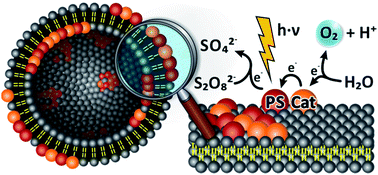Photocatalytic water oxidation at soft interfaces†
Abstract
Molecular water oxidation catalysts have been, for the first time, co-embedded with a photosensitizer into phospholipid membranes. The functionalized small unilamellar vesicles produce molecular oxygen by photocatalysis when irradiated with visible light in aqueous buffer. The two dimensional assembly of the catalysts at the lipid–water interface mimics photoactive membranes in biology and allows photocatalytic water oxidation at very low catalyst concentrations of 500 nM, which cannot be reached in homogeneous systems. Highest TONs are obtained below the membrane's main transition temperature indicating that phase separation, clustering and a limited dynamic enhance the photocatalytic activity of the assembly. The concept of membrane co-embedding can be applied to various combinations, ratios and concentrations of photosensitizers and water oxidizing catalysts, providing a new approach for artificial photosynthesis.


 Please wait while we load your content...
Please wait while we load your content...